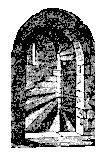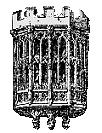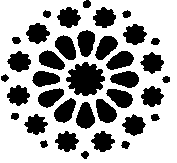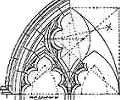
Gothic Design
Learn More.
| HOME Feature Articles Stone Carver's Tour Virtual Cathedral Cathedral Tours Gothic Field Guide GOTHIC GEOMETRY Virtual Abbey Medieval Art Tours Castle Tours Links Resources About The Site FAQ |
|
|
|
New! The Gothic Field Guide translated in Belorussian provided by Galina Miklosic at Webhostinggeeks. ambulatory
- circular aisle which wraps around the apse. apse - (Lat. apsis, an arch) The semicircular or polygonal termination to the choir or aisles of a church. See cathedral and diagram. arch
- the pointed arch is widely regarded as the main identifiable
feature of Gothic architecture (distinct from the round arch of
the Romanesque period). The most common Gothic arches are the
Lancet, Equilateral and Ogee. buttress
- a mass of stone built up to support a wall, usually necessary
to strengthen those of great height. See flying cathedral
- (cathedra, seat or throne) the principal church of a
province or diocese, where the throne of the bishop is placed.
By tradition, a cathedral always faces west - toward the setting
sun while congregants face east toward the rising sun - a symbol
of Christ's ascension into heaven.
chancel - part of the altar for the clergy or choir, bordered by railings. chapels - the recesses on the sides of aisles in cathedrals and abbey churches. Sometimes known as chantries. Chapter
House - administrative center of a cathedral, traditionally
organized for overseeing construction. choir
screen - decorated screen of wood or stone separating the
choir from the rest of the cathedral.
clerestory - 'clear story,' the upper story of a church where it rises above the aisle roof. Window openings, usually of stained glass, allow extra light into the interior. cloister
(Lat. claustrum) - an inner courtyard or central square
closed by the four sides of a monastery sometimes situated
on the south side of a cathedral. The walkway, or ambulatory,
is usually protected by a roof supported by columns.
corbel
- a projecting bracket, sometimes carved and decorated, used to
help support weight from above. crocket
- a small ornament projecting from the sloping angles of pinnacles,
spires, etc., typically depicting stylized foliage. embattled
molding - having indentions
like those of a battlement.
finial
- the top or finishing stone of a pinnacle.
flying
buttress
- a buttress arched over at the top to engage with a main wall.
A principal feature of Gothic architecture, lending strength and
solidity to the main structure. Galilee
porch - a porch at the western end of a church
or cathedral; a biblical reference to Christ leading his disciples
after the resurrection into Galilee. gargoyle
- a spout usually carved in the shape of an animal or demon,
and connected to a gutter for throwing rain water from the roof
of a building. See
Gothic Field Guide Spotlight.
grotesque - a carving usually of a demon, dragon, or half human/half animal, serving no utilitarian purpose. Often confused with gargoyles.
impost
- the row of stones on which an arch rests. jamb
- the stones forming the side of a door or window.
jamb
figures - located on either
side of the main portal door; the first carved figures a visitor
meets on a visit to a Gothic cathedral. Traditionally depicting
Old Testament prophets or martyred saints. keystone
- the central stone of an arch that locks the other units in place.
See voussoir. Lancet
arch - a Gothic pointed arch usually applied to long, narrow
windows. See arch. Lady chapel - the easternmost chapel of a cathedral, intended for quiet contemplation and the occasional special service. misericord (Lt. mercy)- pivoting wooden seats in choir stalls. They were lifted up to provide relief for clergy who had to stand during long church services. Misericords are often highly carved. More at Resources: Misericords.
mullions
- stone piers dividing a window into two or more lights.
nave
(Lt. a ship) - the main body of a church or cathedral.
Sometimes defined as the central aisle only.
niche
(Fr. a nest) - a recess in a wall for the reception of
a statue. oculus - a small circular or eye-shaped window. ogee
- the "s" shaped molding that universally typifies Gothic. See
also arch. Oriel window - appearing in chapels, public and private houses in the Gothic style, a window that projects from the outer face of a wall and supported by corbels. Also known as a bay window.
Perpendicular
style - the name given to late
15th century English Gothic architecture as lines became longer
and carving more elaborate. Also know as Flamboyant style. pinnacle
- a slender, pointed summit placed on top of buttresses, gables,
etc. plate
tracery - the simplest, earliest
form of tracery, ca. 1300.
quoin
- a corner stone. relieving
arch
- added support over a window or doorway, to bear the weight of
the masonry wall above. Rose
window
- a large, circular window with heavily foliated tracery branching
out from a common center. More
at The Virtual Gothic Cathedral
&
Rose
Window Geometry
springer - the horizontal stone which the first arch stone rests upon, or springs from.
transept
- in cathedral architecture, the north and south projections or
"arms" of the cross. See porch, cathedral. trifoil -
tracery in three foils. See
also cinquefoil.
tympanum
- a panel above a main portal, or doorway, usually heavily decorated. voussoir
- a wedge-shaped component of an arch. The center voussoir is
the keystone. wreathed
columns - those twisted in the
shape of a screw as illustrated, right. zigzag - an ornamental molding in both Romanesque and Gothic architecture. Also known as dancette or chevron molding.
|
Sponsored
Links
copyright © 2017
 buttress.
buttress.


 fan
tracery vaulting - a system
of ceiling vaulting with all ribs having the same curve, resembling
the folds of a fan.
fan
tracery vaulting - a system
of ceiling vaulting with all ribs having the same curve, resembling
the folds of a fan. 





 tracery
- ornamental stonework most often seen supporting window glass
in the form of trifoils and cinquefoils. Sometimes used
merely as decoration on panels and moldings and then called 'blind'
tracery. More
at
tracery
- ornamental stonework most often seen supporting window glass
in the form of trifoils and cinquefoils. Sometimes used
merely as decoration on panels and moldings and then called 'blind'
tracery. More
at 